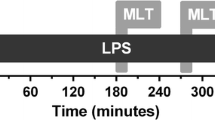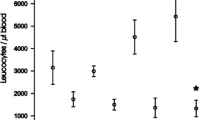Abstract
Melatonin has been shown to enhance the immune response under immune-compromised conditions. However, its immune-modulatory effects under inflammatory conditions are unclear at present. Both pro- and anti-inflammation has been reported. To study time-dependent effects of melatonin on the general immune response during endotoxemia in more detail, we used two models in male rats: per-acute endotoxemia was induced by lipopolysaccharide (LPS) bolus injection (2.5 mg/kg), sub-acute endotoxemia by LPS infusion (2.5 mg/kg × h). Melatonin was applied directly before and 2 h after LPS administration (3 mg/kg, each). The LPS-induced formation of the pro-inflammatory cytokines tumor necrosis factor alpha, interferon-gamma, interleukin (IL)-1α/β, IL-5, and IL-6 and of the anti-inflammatory cytokine IL-10 was further amplified by melatonin, although it was only significant during per-acute endotoxemia. In both models, melatonin had no effect on the LPS-induced nitric oxide release. These findings show that exogenous melatonin is capable of enhancing the general immune response under inflammatory conditions.

Similar content being viewed by others
References
Bone, R. 1991. Gram-negative sepsis. Background, clinical features, and intervention. Chest 100: 802–808.
Trampuz, A., and W. Zimmerli. 2003. Pathogenesis und Therapie der Sepsis. Schweiz Medical Forum 35: 811–818.
Vincent, J.L., E.C. Serrano, and A. Dimoula. 2011. Current management of sepsis in critically ill adult patients. Expert Review of Anti-Infective Therapy 9: 847–856.
Poli-de-Figueiredo, L.F., A.G. Garrido, N. Nakagawa, and P. Sannomiya. 2008. Experimental models of sepsis and their clinical relevance. Shock 30(Suppl 1): 53–59.
Remick, D.G., and P.A. Ward. 2005. Evaluation of endotoxin models for the study of sepsis. Shock 24: 7–11.
Guardiola-Lemaitre, B. 1997. Toxicity of melatonin. Journal of Biological Rhythms 12: 697–706.
Challet, E. 2007. Minireview: entrainment of the suprachiasmatic clockwork in diurnal and nocturnal mammals. Endocrinology 148: 5648–5655.
Luchetti, F., B. Canonico, M. Betti, et al. 2010. Melatonin signaling and cell protection function. FASEB Journal 24: 3603–3624.
Tan, D.X., L.C. Manchester, R. Hardeland, et al. 2003. Melatonin: a hormone, a tissue factor, an autocoid, a paracoid, and an antioxidant vitamin. Journal of Pineal Research 34: 75–78.
Reiter, R.J., D.-X. Tan, L.C. Manchester, et al. 2007. Medical implication of melatonin: receptor-mediated and receptor-independent actions. Advanced Medical Science 52: 11–28.
Tan, D.X., L.D. Chen, B. Poeggeler, et al. 1993. Melatonin: a potent endogenous hydroxyl radical scavenger. Endocrine Journal 1: 57–60.
Genade, S., A. Genis, K. Ytrehus, et al. 2008. Melatonin receptor-mediated protection against myocardial ischaemia/reperfusion injury: role of its anti-adrenergic actions. Journal of Pineal Research 45: 449–458.
Jockers, R., P. Maurice, J.A. Boutin, and P. Delagrange. 2008. Melatonin receptors, heterodimerization, signal transduction and binding sites: what’s new? British Journal of Pharmacology 154: 1182–1195.
Krause, D.N. 1991. Melatonin receptors. Annual Review of Pharmacology and Toxicology 31: 549–568.
Carrillo-Vico, A., P.J. Lardone, N. Alvarez-Sanchez, et al. 2013. Melatonin: buffering the immune system. International Journal of Molecular Sciences 14: 8638–8683.
Tian, Y.M., G.Y. Zhang, and Y.R. Dai. 2003. Melatonin rejuvenates degenerated thymus and redresses peripheral immune functions in aged mice. Immunology Letters 88: 101–104.
Akbulut, K.G., B. Gönül, and H. Akbulut. 2001. The effects of melatonin on humoral immune responses of young and aged rats. Immunological Investigations 30: 17–20.
Maestroni, G.J., A. Conti, and W. Pierpaoli. 1986. Role of the pineal gland in immunity. Circadian synthesis and release of melatonin modulates the antibody response and antagonizes the immunosuppressive effect of corticosterone. Journal of Neuroimmunology 13: 19–30.
Haldar, C., S. Rai, and R. Singh. 2004. Melatonin blocks dexamethasone-induced immunosuppression in a seasonally breeding rodent Indian palm squirrel, Funambulus pennan. Steroids 69: 367–377.
Miller, S.C., P.S.R. Pandi, A.I. Esquifino, et al. 2006. The role of melatonin in immuno-enhancement: potential application in cancer. International Journal of Experimental Pathology 87: 81–87.
Srinivasan, V., S.R. Pandi-Perumal, A. Brzezinski, et al. 2011. Melatonin, immune function and cancer. Recent Patent Endocrine Metabolic Immune Drug Discoveries 5: 109–123.
Regodon, S., P. Martin-Palomino, R. Fernandez-Montesinos, et al. 2005. The use of melatonin as a vaccine agent. Vaccine 23: 5321–5327.
Regodon, S., M. Del Prado Miguez, I. Jardin, et al. 2009. Melatonin, as an adjuvant-like agent, enhances platelet responsiveness. Journal of Pineal Research 46: 275–285.
Shang, Y., S.-P. Xu, Y. Wu, et al. 2009. Melatonin reduces acute lung injury in endotoxemic rats. Chinese Medical Journal 122: 1388–1393.
Wu, C.-C., C.-W. Chiao, G. Hsiao, et al. 2001. Melatonin prevents endotoxin-induced circulatory failure in rats. Journal of Pineal Research 30: 147–156.
Lowes, D.A., N.R. Webster, M.P. Murphy, and H.F. Galley. 2013. Antioxidants that protect mitochondria reduce interleukin-6 and oxidative stress, improve mitochondrial function, and reduce biochemical markers of organ dysfunction in a rat model of acute sepsis. British Journal of Anaesthesia 110: 472–480.
Naidu, K.S., L.W. Morgan, and M.J. Bailey. 2010. Inflammation in the avian spleen: timing is everything. BMC Molecular Biology 11: 104.
Bitzer-Quintero, O.K., G.G. Ortiz, L. Ruiz-Rizo, et al. 2005. Effects of melatonin on plasma levels of TNFa, IL-1 and IL-6 in mice after lipopolysaccharide administration. Biological Rhythm Research 36: 159–168.
Del Angel-Meza, A.R., A.J. Davalos-Marin, L.L. Ontiveros-Martinez, et al. 2011. Protective effects of tryptophan on neuro-inflammation in rats after administering lipopolysaccharide. Biomedicine and Pharmacotherapy 65: 215–219.
Carrillo-Vico, A., P.J. Lardone, L. Naji, et al. 2005. Beneficial pleiotropic actions of melatonin in an experimental model of septic shock in mice: regulation of pro-/anti-inflammatory cytokine network, protection against oxidative damage and anti-apoptotic effects. Journal of Pineal Research 39: 400–408.
Zhong, L.-Y., Z.-H. Yang, X.-R. Li, et al. 2009. Protective effects of melatonin against the damages of neuroendocrine-immune induced by lipopolysaccharide in diabetic rats. Experimental and Clinical Endocrinology and Diabetes 117: 463–469.
Sacco, S., L. Aquilini, P. Ghezzi, et al. 1998. Mechanism of the inhibitory effect of melatonin on tumor necrosis factor production in vivo and in vitro. E J Pharmacology 343: 249–255.
Maestroni, G.J. 1996. Melatonin as a therapeutic agent in experimental endotoxic shock. Journal of Pineal Research 20: 84–89.
Tyagi, E., R. Agrawal, C. Nath, and R. Shukla. 2010. Effect of melatonin on neuroinflammation and acetylcholinesterase activity induced by LPS in rat brain. European Journal of Pharmacology 640: 206–210.
Wang, H., W. Wei, Y.-X. Shen, et al. 2004. Protective effect of melatonin against liver injury in mice induced by Bacillus Calmette-Guerin plus lipopolysaccharide. World Journal of Gastroenterology 10: 2690–2696.
Yavuz, T., D. Kaya, M. Behcet, et al. 2007. Effects of melatonin on Candida sepsis in an experimental rat model. Advances in Therapy 24: 91–100.
Wu, J.-Y., M.-Y. Tsou, T.-H. Chen, et al. 2008. Therapeutic effects of melatonin on peritonitis-induced septic shock with multiple organ dysfunction syndrome in rats. Journal of Pineal Research 45: 106–116.
Petrat, F., J. Drowatzky, K. Boengler, et al. 2011. Protection from glycine at low doses in ischemia-reperfusion injury of the rat small intestine. European Surgical Research 46: 180–187.
Effenberger-Neidnicht, K., M. Al Nator, L. Brencher, et al. 2013. Prevention of endotoxin-induced hypotension in rats by the circadian hormone melatonin. Infection 41: S11–S12.
Hamburger, T., M. Broecker-Preuss, M. Hartmann, et al. 2013. Effects of glycine, pyruvate, resveratrol, and nitrite on tissue injury and cytokine response in endotoxemic rats. Journal of Surgical Research 183: e7–e21.
Di, W.-L., A. Kadva, O. Djahanbakhch, and R. Silman. 1998. Radioimmunoassay of bound and free melatonin in plasma. Clinical Chemistry 44: 304–310.
Rittirsch, D., M.A. Flierl, and P.A. Ward. 2008. Harmful molecular mechanisms in sepsis. Nature Reviews Immunology 8: 776–787.
Jean-Baptiste, E. 2007. Cellular mechanisms in sepsis. Journal of Intensive Care Medicine 22: 63–72.
Dinarello, C.A. 1997. Pro-inflammatory and anti-inflammatory cytokines as mediators in the pathogenesis of septic shock. Chest 112: 321S–329S.
Green, L.C., D.A. Wagner, and J. Glogowski. 1982. Analysis of nitrate, nitrite, and [15N]nitrate in biological fluids. Analytical Biochemistry 126: 131–138.
Habbal, O.A., and A.A. Al-Jabri. 2009. Circadian rhythm and the immune response: a review. International Reviews of Immunology 28: 93–108.
Vgontzas, A.N., D.A. Papanicolaou, E.O. Bixler, et al. 1999. Circadian interleukin-6 secretion and quantity and depth of sleep. Endocrinology and Metabolism 84: 2603–2607.
Dominguez-Rodriguez, A., P. Abreu-Gonzalez, M. Garcia, et al. 2004. Light/dark patterns of interleukin-6 in relation to the pineal hormone melatonin in patients with acute myocardial infarction. Cytokine 26: 89–93.
Oliveira, L.G., C.C. Kuehn, C.D. Santos, et al. 2010. Enhanced protection by melatonin and meloxicam combination in experimental infection by Trypanosoma cruzi. Parasite Immunology 32: 245–251.
Valero, N., E. Bonilla, H. Pons, et al. 2002. Melatonin induces changes to serum cytokines in mice infected with the Venezuelan equine encephalomyelitis virus. Transactions of the Royal Society of Tropical Medicine and Hygiene 96: 348–351.
Arias, J., E. Melean, N. Valero, et al. 2003. Effect of melatonin on lymphocyte proliferation and production of interleukin-2 (il-2) and interleukin-1 beta (il-1 beta) in mice splenocytes. Investigación Clínica 44: 41–50.
Currier, N.L., L.Z. Sun, and S.C. Miller. 2000. Exogenous melatonin: quantitative enhancement in vivo of cells mediating non-specific immunity. Journal of Neuroimmunology 104: 101–108.
Maestroni, G.J. 2001. The immunotherapeutic potential of melatonin. Experimental Opinion Investigative Drugs 10: 467–476.
Maestroni, G.J. 1995. T-helper-2 lymphocytes as a peripheral target of melatonin. Journal of Pineal Research 18: 84–89.
Carrillo-Vico, A., A. Garcia-Perganeda, L. Naji, et al. 2003. Expression of membrane and nuclear melatonin receptor mRNA and protein in the mouse immune system. Cellular and Molecular Life Sciences 60: 2272–2278.
Drazen, D.L., and R.J. Nelson. 2001. Melatonin receptor subtype MT2 (Mel 1b) and not mt1 (Mel 1a) is associated with melatonin-induced enhancement of cell-mediated and humoral immunity. Neuroendocrinology 74: 178–184.
Kidd, P. 2003. Th1/Th2 balance: the hypothesis, its limitations, and implications for health and disease. Alternative Medicine Review 8: 223–246.
Standage, S.W., and H.R. Wong. 2011. Biomarkers for pediatric sepsis and septic shock. Expert Review of Anti-Infective Therapy 9: 71–79.
Xing, Z., J. Gauldie, G. Cox, et al. 1998. IL-6 is an antiinflammatory cytokine required for controlling local or systemic acute inflammatory responses. Journal of Clinical Investigation 101: 311–320.
Loddick, S.A., A.V. Turnbull, and N.J. TRothwell. 1998. Cerebral interleukin-6 is protective during permanent focal cerebral ischemia in the rat. Journal of Cerebral Blood Flow and Metabolism 18: 176–179.
Toulmond, S., X. Vige, D. Fage, and J. Benavides. 1992. Local infusion of interleukin-6 attenuates the neurotoxic effects of NMDA on rat striatal cholinergic neurons. Neuroscience Letters 144: 49–52.
Xu, L.L., A. Kitani, I. Fuss, and W. Strober. 2007. Cutting edge: regulatory T cells induce CD4+CD25-Foxp3- T cells or are self-induced to become TH17 cells in the absence of exogenous TGF-b. Journal of Immunology 178: 6725–6729.
Bettelli, E., Y. Carrier, W. Gao, et al. 2006. Reciprocal developmental pathways for the generation of pathogenic effector TH17 and regulatory T cells. Nature 441: 235–238.
Wang, T.S., and J.C. Deng. 2008. Molecular and cellular aspects of sepsis-induced immunosuppression. Journal of Molecular Medicine (Berl) 86: 495–506.
Benjamim, C.F., C.M. Hogaboam, and S.L. Kunkel. 2004. The chronic consequences of severe sepsis. Journal of Leukocyte Biology 75: 408–412.
Li, C.X., D.D. Liang, G.H. Xie, et al. 2013. Altered melatonin secretion and circadian gene expression with increased proinflammatory cytokine expression in early-stage sepsis patients. Molecular Medicine Reports 7: 1117–1122.
Pinheiro da Silva F, Cesar Machado MC, Sallet PC et al. Neuropeptide downregulation in sepsis. Inflammation 2013 (in press).
Acknowledgments
We would like to thank Mrs. Katrin Rehmann for carrying out the Bio-Plex-Assay.
Author information
Authors and Affiliations
Corresponding author
Rights and permissions
About this article
Cite this article
Effenberger-Neidnicht, K., Brencher, L., Broecker-Preuss, M. et al. Immune Stimulation by Exogenous Melatonin During Experimental Endotoxemia. Inflammation 37, 738–744 (2014). https://doi.org/10.1007/s10753-013-9792-y
Published:
Issue Date:
DOI: https://doi.org/10.1007/s10753-013-9792-y




